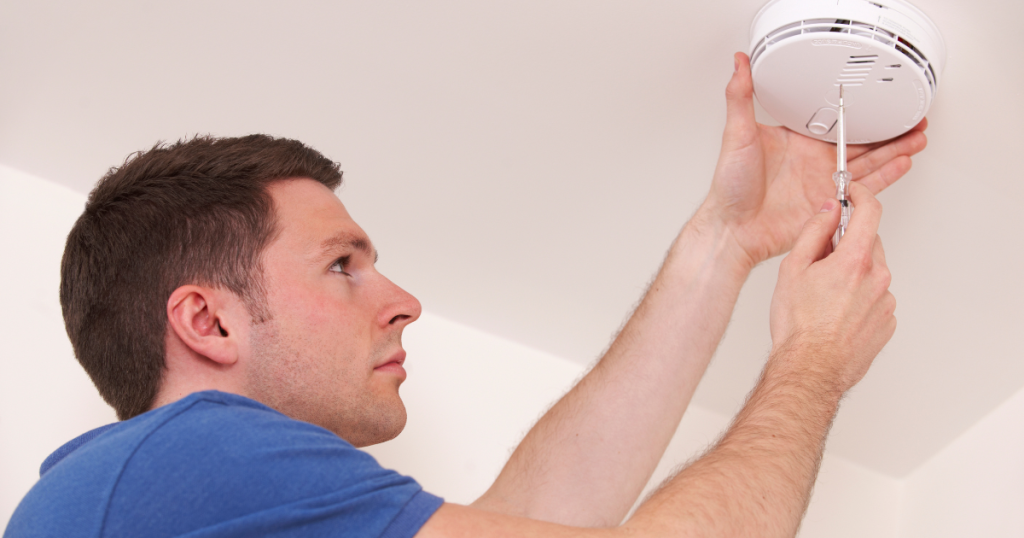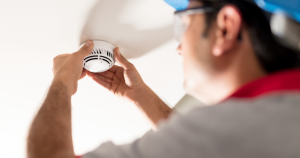Did you know that 96% of homes in the USA are now equipped with smoke detectors?
We understand that safety in your home should always be your top priority and one of the essential devices every household should have is a smoke detector.
A smoke detector helps you detect the presence of smoke in your home, alerting you to possible fire. Installing a hardwired smoke detector in your home can be challenging and overwhelming, so you can leave the job to our professional electricians from Assurance Electrical!
In this blog, we’ll guide you through the process of how we install a hardwired smoke detector in your home, to give you an overview of our entire procedure. Let’s get started!
Step-by-Step Process of Installing Hardwired Smoke Detectors

Hardwired smoke alarms should be installed properly to ensure their functionality. Below are the general steps on how our licensed electricians install hardwired detectors.
Step 1: Choose the Perfect Location for Your Smoke Detector:
Choosing the right smoke detector location is crucial. We make sure to install smoke detectors in easily accessible locations, near an electrical outlet, and close to sleeping areas for optimal results.
Avoid placing it near vents or windows, as it can interfere with its detection capabilities. Consider installing multiple smoke detectors in different areas of your home too to improve safety.
Step 2: Shut Off Power to the Electrical Circuit
Before we begin installing your smoke detector, we need to shut off power to the electrical box in the area where we are planning to install it. This will ensure that no continuous electrical charge will run throughout the installation procedure.
Most homes that use electrical smoke detectors compared to battery-powered ones, and this installation can pose danger if not done by a professional.
Step 3: Install the Mounting Bracket
After you’ve chosen the perfect location and shut off power, we will install the mounting plate of the smoke alarm.
We install the mounting bracket tightly onto the ceiling light fixture or the existing wall outlet using the provided screws.
The detector’s mounting plate holds the unit and hides the smoke detector cable, giving your device a sleek and professional look.
Step 4: Connect the Wiring
Connecting the wiring is always the tricky part, but don’t worry – we’ve got you covered. If you have an existing electrical connection in that location, we’ll need to remove the old detector and connect the new one to the wiring using wire nuts.
We thoroughly follow the manufacturer’s instructions and make sure to connect all wires accordingly. If multiple detectors are being installed, we usually run a 3-wire cable onto the first detector connected to each subsequent smoke detector.
After connecting the wires, we tuck them back securely into the mounting plate.
Step 5: Testing Out the Smoke detector:
After completing all the steps, we turn the power back on and test the smoke detector. Press the test button, and if the alarms sound, congratulations! We have successfully installed a hardwired smoke detector in your home.
If it doesn’t work correctly, then we’ll check the wires and connections again. Always remember to have us test your smoke detector regularly, even after installation.
What Are the Types of Hardwired Smoke Detectors?

There are several different types of hardwired smoke detectors available in the market. Here are some of them:
- Ionization Smoke Detectors: These detectors use a small amount of radioactive material to ionize the air in the sensing chamber. When smoke enters the chamber, it disrupts the ionization process, triggering the alarm. Ionization smoke detectors are effective at detecting fast-flaming fires.
- Photoelectric Smoke Detectors: Photoelectric smoke detectors use a light source and a light-sensitive sensor. When smoke particles enter the sensing chamber, they scatter the light, which triggers the alarm. These detectors are particularly sensitive to slow, smoldering fires.
- Dual-Sensor Smoke Detectors: Dual-sensor smoke detectors combine both ionization and photoelectric technologies in one unit. They provide broader coverage and can detect a wider range of fire types, including both fast-flaming and slow-smoldering fires.
- Combination Smoke and Carbon Monoxide Detectors: These detectors offer dual functionality by combining smoke detection with carbon monoxide (CO) detection. They can provide early warning for both fire and CO gas, offering enhanced safety.
- Interconnected Smoke Detectors: Interconnected smoke detectors are wired together so that when one unit detects smoke, all interconnected units in the system also activate. This provides widespread notification throughout the home or building.
Have Your First Smoke Detector Installed By Our Professional Electricians!

Installing a hardwired smoke detector can be easily done by our professionals and it’s a small price to pay for your safety in your home.
Keep in mind that safety in your home starts with preventing disasters before they occur and with the addition of the hardwired smoke detector, you have made a significant safety impact on your residence.
So go ahead and invest in that smoke detector, whether you need installation, repair, or maintenance, our team at Assurance Electrical is ready to help you any time of the day! Check out our limited-time free whole home safety evaluation!
Jeff Brandlin is the founder of Assurance Electrical Services, LLC. He started in the electrical industry when he was 21 and had worked in several electrical firms before founding Assurance Electrical. Jeff is dedicated to providing the best quality service to his clients and always puts their needs first. Outside work, Jeff enjoys spending time with his wife and children.





